Introduction
The Eagle Gold Project is an advanced stage gold exploration project and mine in the Yukon Territory of Canada that was the flagship project of Victoria Gold Corp [TSX-V: VIT]. The project is located within their larger 646km2 Dublin Gulch property, an area which has seen small-scale mining activity for more than a century, mainly focused on placer gold deposits but also silver from high-grade vein systems.
The company completed a Feasibility Study on the project in February 2012. Construction of the mine began in 2018 and the mine opened in July of 2020 as the largest gold mine in the Yukon. In June 2024 operations were suspended following a landslide and failure of the heap leach pad. An investgation is underway and operations will not restart until the provincial government authorizes it. Victoria Gold entered court-ordered receivership in August of 2024. Clean up is expected to cost between $100 and 150 million.
Location & Access
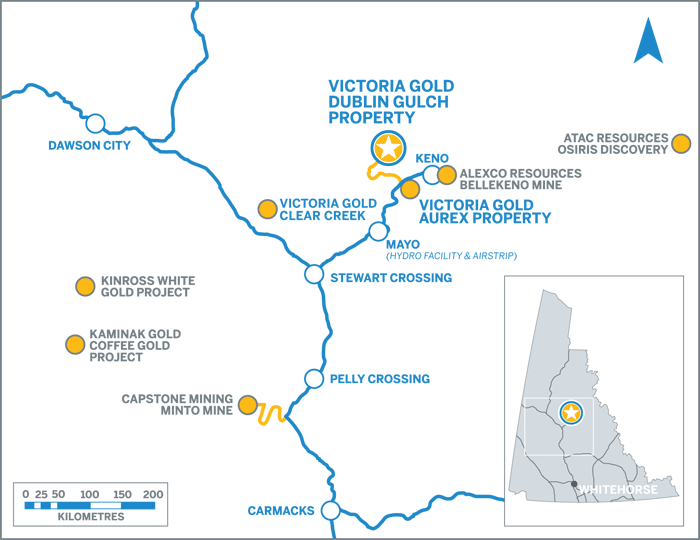
The Dublin Gulch property is located approximately 85km by an all year road from the village of Mayo in the central Yukon, and is about a 6 hour drive north of Whitehorse, the Yukon’s only city.
There is also an airport at Mayo which can significantly reduce travel times and will likely be used in the future for crew rotations. The town of Mayo has healthcare facilities, local government offices, fuel depots, groceries and accommodation, although Victoria Gold had an established 100-person camp already built on the property.
Regional Geology

Dublin Gulch lies within the Tintina Gold Belt, which extends for 1,200km from Alaska and into British Columbia. The property lies along a series of geologic structures known as thrust faults which acted as conduits for rising magma and the eventual emplacement of granite-like igneous rocks known as granodiorites. This took place during a Late Cretaceous (~94 million years ago) period of tectonic activity along the west cost of North America.
The Eagle Gold Project is located along an elongated intrusion about 6km long and 2km wide, and conforms to the Reduced Intrusion Related Gold System (RIRGS) ore model. These are a more recently understood type of gold deposit and are associated with a number of gold systems in the Yukon and Alaska.
The strain from the thrust faults opened up a wider area for mineralisation, which has been dubbed the ‘Potato Hills Trend’ (PHT). This is a 13km long belt of gold-bismuth-antimony and silver-lead-zinc mineralisation that extends along the edge of the Dublin Gulch stock to the northeast and the southwest. The PHT hosts several other mineralized targets that are in various stages of exploration. The Olive, Shamrock and Popeye Zones are in close proximity to the Eagle Project and also have gold, whereas the more distal Rex-Peso Zone is known historically for its silver mines.
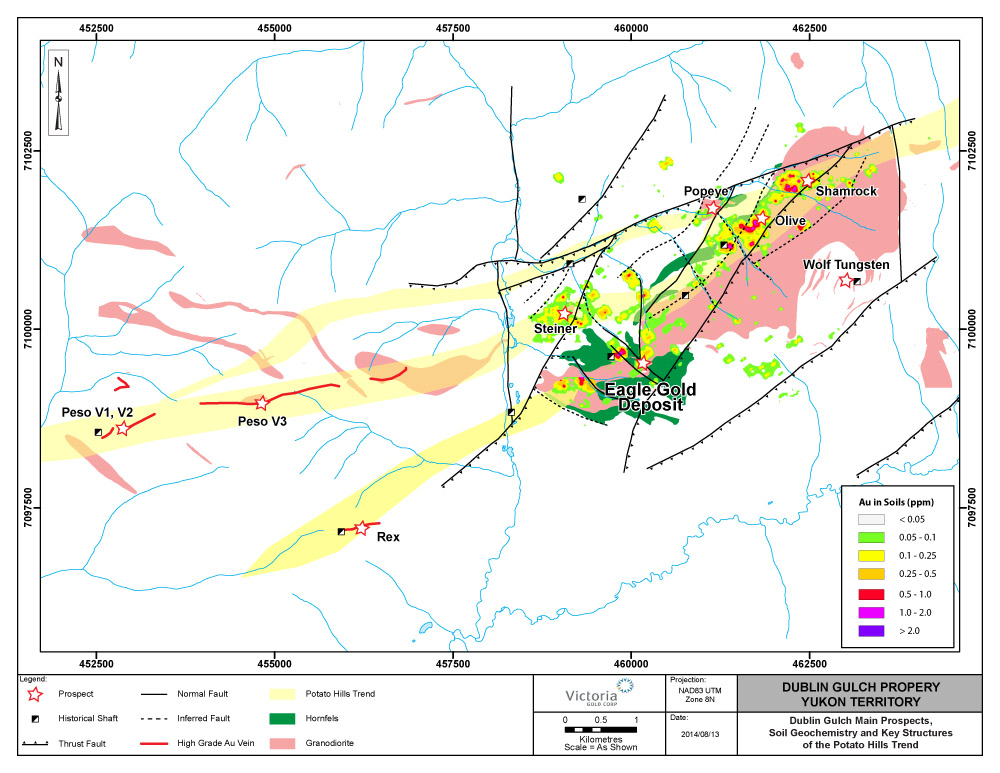
Exploration History & Development
Some of the Yukon’s earliest mining activity took place in the Dublin Gulch area with the first recorded gold in 1898, but it was not until the 1980’s that geologists started to pursue the source of the gold and explore the area accordingly. The site has changed hands several times in its history, but it has been with Victoria Gold Corp. that the biggest advancements have been made since they acquired it from the now defunct Strata Gold Corp. Exploration of satellite deposits continues in order to create ‘upside’ to the property as a whole.
As of 2018, when construction began, probable reserves were 2.7 Moz gold at 0.67 g/t. The mine opened in July of 2020.
The mine is an open pit ‘drill, blast, shovel and haul’ operation. Ore is processed through a series of three crushing mills, to a final size of 6.3mm and then conveyed to an in-valley heap leach, where it is stacked in 10m benches and leached for 150 days. The ‘pregnant’ leachate is then pumped to a plant where the gold is stripped from solution and poured into bars.
Discussion
Victoria Gold Corp. had significantly advanced the project and opened the Yukon’s largest gold mine before it all came crashing down.
The estimated capital cost of opening the mine was $430 million was lofty and required Victoria to offload some of its other Yukon and Nevada based assets in order to reduce expenditures and to raise cash. The remaining balance was raised through loans. The mine was able to operate for less than 4 years before the heap leach failure.
While many projects in the far north get bogged down by the high costs of operating, the Victoria Gold had an advantages over other remote projects: The area hosted a nearby mining operation (formerly Alexco, now Hecla) and benefits from all of it’s pre-existing infrastructure including an all-season road and facilities in the mining-friendly town of Mayo. The satellite deposits may also add value to the project as a whole.
After a few successful years of operation the heap leach failure is a major black mark on the operation. The cause, and full effects, of the spill will not be clear for some time. Initial reports indicate highly toxic cyanide reached several local creeks. Cyanide is quickly broken down by exposure to UV radiation in sunlight, so it won’t persist in the environment for long, but this is probably cold comfort the regions inhabitants. Investigation and containment activities have been hampered by wildfires in the area.
Despite this failure, there is still hope that the mine will re-open following clean and re-evaluation of the operation. The 2014 Mount Polley tailings dam breach illustrates that such failures can be remediated, albeit at considerable cost. The nature of the spill at Eagle is different (active leaching versus already processed tailings), and it remains to be seen how the situation will develop.
Subscribe for Email Updates

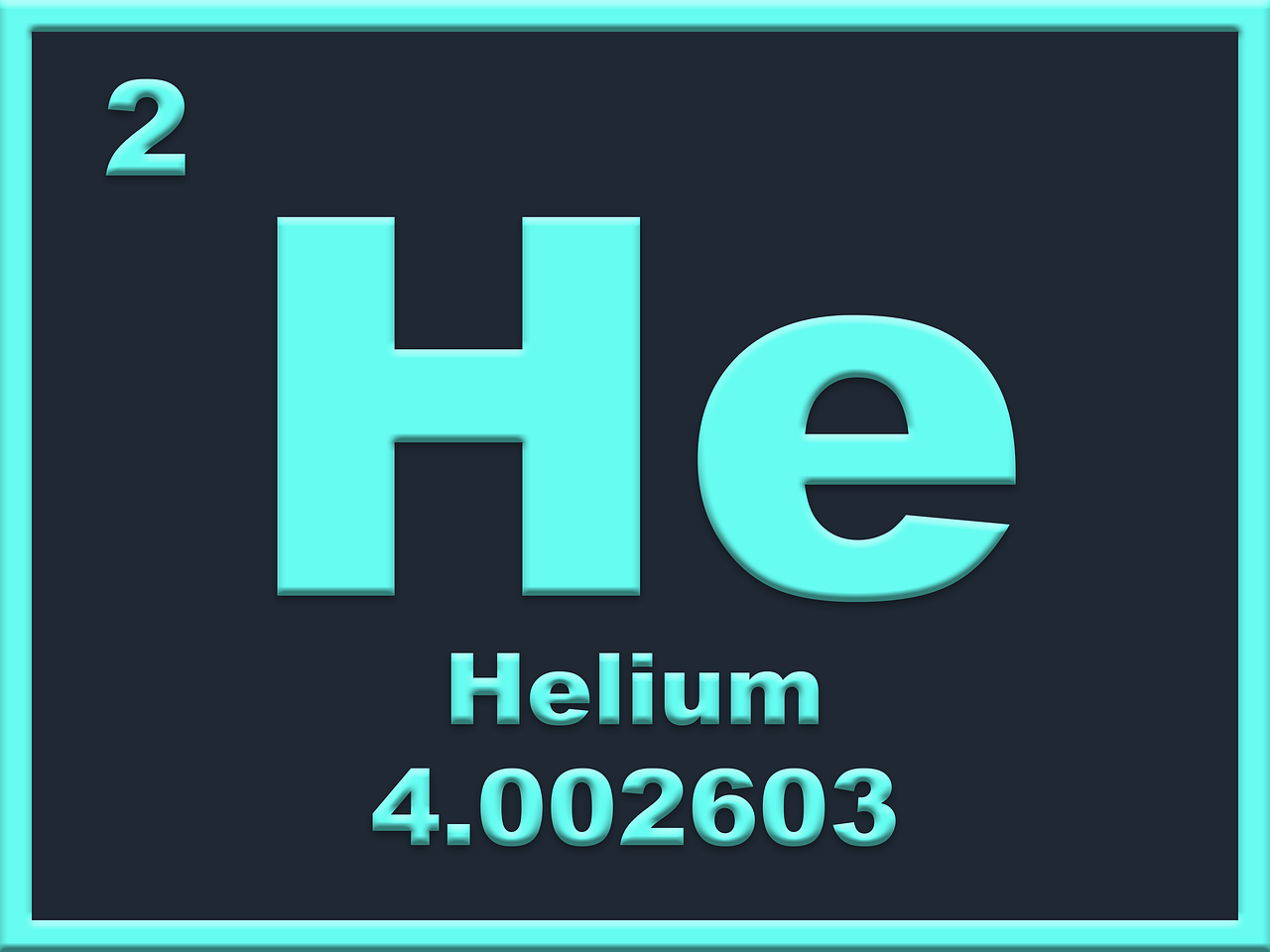
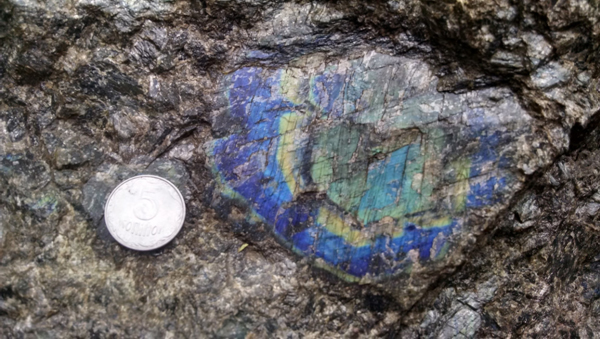
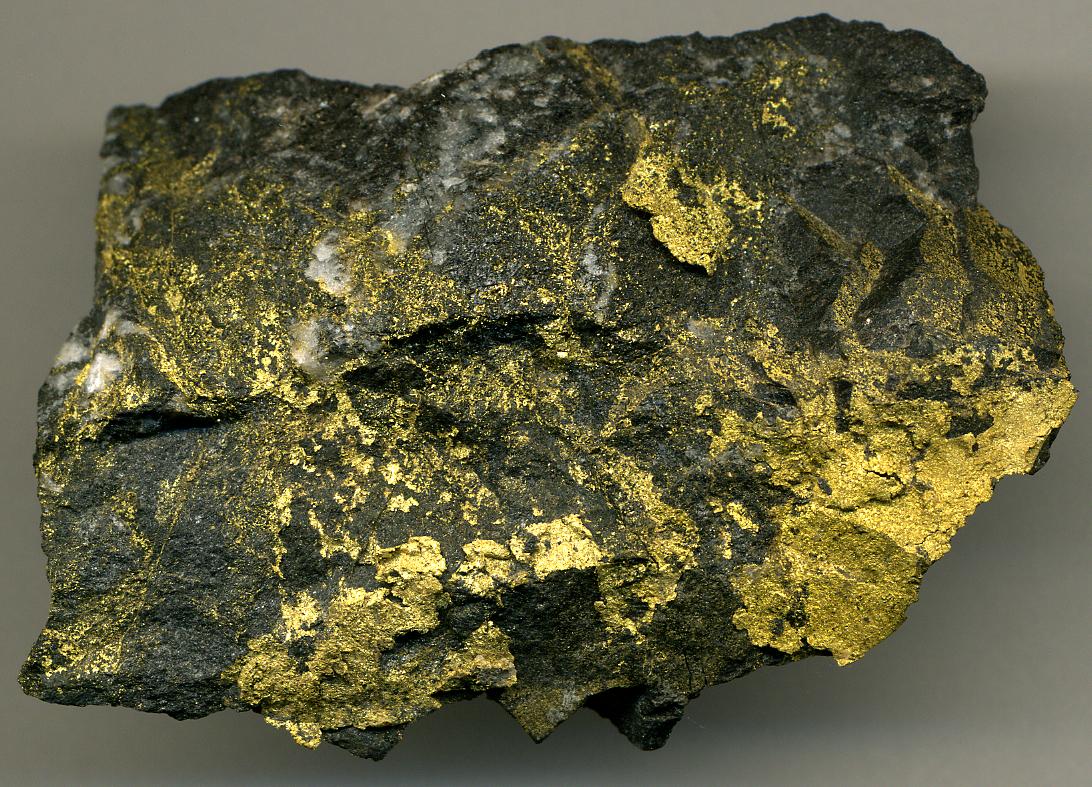



An excellent article summarizing the Eagle Gold project! I am currently completing my MSc studying the geochemistry of the Dublin Gulch deposit. A couple of points which I wanted to raise with regards to the geology section:
1) The age of the deposit and hydrothermal mineralization are c. 94 Ma and associated with Cordilleran tectonics rather than the Laramide orogeny.
2) The pluton itself is larger than stated above at roughly 6 x 2 km.
At current, I believe that exploration efforts are focused on generating a compliant resource for the Olive Zone and assessing if the ore there could be processed in the same manner as that found in the Eagle Zone.
Great to see this exciting project being discussed!
Nice to see individuals with a passion for geology. Very best of luck with completing your MSc, Fraser. You made a couple of interesting points and I was curious where you came by that information on genesis and pluton size? I too have a strong interest in Victoria Gold, particularly their Dublin Gulch property and haven’t seen that (new?) information. I know there is a pluton just off their eastern border that is about 6 km x 2 km, featured here recently in a previous article. Cheers.
Hi William. Thanks for your response! The age of the pluton is constrained by U-Pb ages on zircon and titanite by Murphy (1997) and Selby et al. (2003) which are c. 93-94 Ma. Selby also did Re-Os dating on hydrothermal molybdenite which gave an age of c. 93 Ma. With regards to the size of the pluton, the commonly quoted 2 x 1 km is perhaps the size of the Eagle Zone of the deposit. The full pluton is around 6 km long and 2 km wide at it’s widest, which is verifiable by using the scale in the above figures. You can find more information on their work on the Olive Zone in this press release: http://tinyurl.com/nubpdt3 and in this description of the Olive Zone: http://tinyurl.com/psq7uzw
Thanks for that Fraser, great stuff and very informative for me. I greatly appreciate your dedication to the advancement of RIRGS knowledge. A great choice for a Masters thesis that will likely provide some real insights and understanding to this relatively new deposit class. You have certainly provided me a good clue as to how I might discover if some nearby geology (the pluton to the east of “nugget”) was likely involved in the same event(s) or an entirely different scenario. Kindest regards.
Thanks Fraser. We’ve updated the article per your feedback.